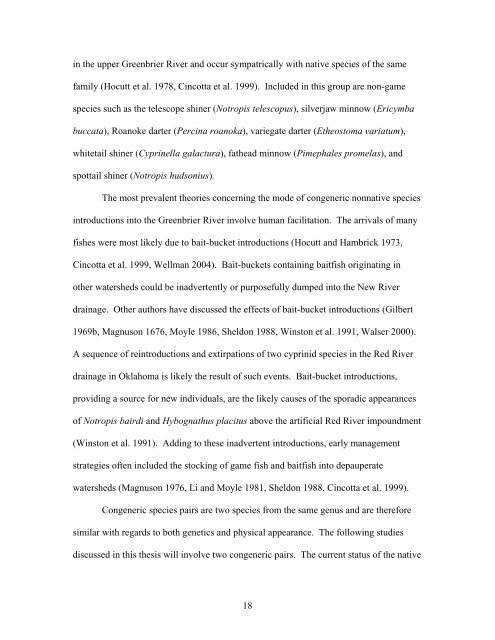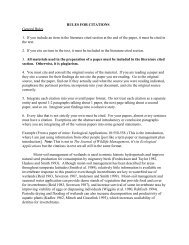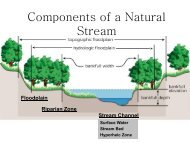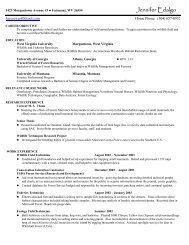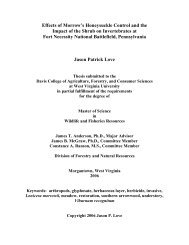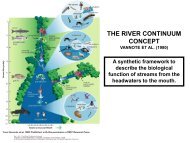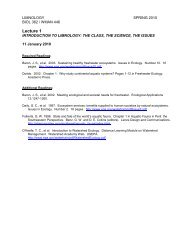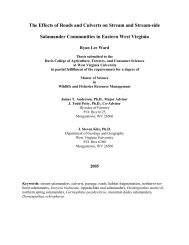An Experimental Study of Vertical Habitat Use and Habitat Shifts in ...
An Experimental Study of Vertical Habitat Use and Habitat Shifts in ...
An Experimental Study of Vertical Habitat Use and Habitat Shifts in ...
Create successful ePaper yourself
Turn your PDF publications into a flip-book with our unique Google optimized e-Paper software.
<strong>in</strong> the upper Greenbrier River <strong>and</strong> occur sympatrically with native species <strong>of</strong> the same<br />
family (Hocutt et al. 1978, C<strong>in</strong>cotta et al. 1999). Included <strong>in</strong> this group are non-game<br />
species such as the telescope sh<strong>in</strong>er (Notropis telescopus), silverjaw m<strong>in</strong>now (Ericymba<br />
buccata), Roanoke darter (Perc<strong>in</strong>a roanoka), variegate darter (Etheostoma variatum),<br />
whitetail sh<strong>in</strong>er (Cypr<strong>in</strong>ella galactura), fathead m<strong>in</strong>now (Pimephales promelas), <strong>and</strong><br />
spottail sh<strong>in</strong>er (Notropis hudsonius).<br />
The most prevalent theories concern<strong>in</strong>g the mode <strong>of</strong> congeneric nonnative species<br />
<strong>in</strong>troductions <strong>in</strong>to the Greenbrier River <strong>in</strong>volve human facilitation. The arrivals <strong>of</strong> many<br />
fishes were most likely due to bait-bucket <strong>in</strong>troductions (Hocutt <strong>and</strong> Hambrick 1973,<br />
C<strong>in</strong>cotta et al. 1999, Wellman 2004). Bait-buckets conta<strong>in</strong><strong>in</strong>g baitfish orig<strong>in</strong>at<strong>in</strong>g <strong>in</strong><br />
other watersheds could be <strong>in</strong>advertently or purposefully dumped <strong>in</strong>to the New River<br />
dra<strong>in</strong>age. Other authors have discussed the effects <strong>of</strong> bait-bucket <strong>in</strong>troductions (Gilbert<br />
1969b, Magnuson 1676, Moyle 1986, Sheldon 1988, W<strong>in</strong>ston et al. 1991, Walser 2000).<br />
A sequence <strong>of</strong> re<strong>in</strong>troductions <strong>and</strong> extirpations <strong>of</strong> two cypr<strong>in</strong>id species <strong>in</strong> the Red River<br />
dra<strong>in</strong>age <strong>in</strong> Oklahoma is likely the result <strong>of</strong> such events. Bait-bucket <strong>in</strong>troductions,<br />
provid<strong>in</strong>g a source for new <strong>in</strong>dividuals, are the likely causes <strong>of</strong> the sporadic appearances<br />
<strong>of</strong> Notropis bairdi <strong>and</strong> Hybognathus placitus above the artificial Red River impoundment<br />
(W<strong>in</strong>ston et al. 1991). Add<strong>in</strong>g to these <strong>in</strong>advertent <strong>in</strong>troductions, early management<br />
strategies <strong>of</strong>ten <strong>in</strong>cluded the stock<strong>in</strong>g <strong>of</strong> game fish <strong>and</strong> baitfish <strong>in</strong>to depauperate<br />
watersheds (Magnuson 1976, Li <strong>and</strong> Moyle 1981, Sheldon 1988, C<strong>in</strong>cotta et al. 1999).<br />
Congeneric species pairs are two species from the same genus <strong>and</strong> are therefore<br />
similar with regards to both genetics <strong>and</strong> physical appearance. The follow<strong>in</strong>g studies<br />
discussed <strong>in</strong> this thesis will <strong>in</strong>volve two congeneric pairs. The current status <strong>of</strong> the native<br />
18


